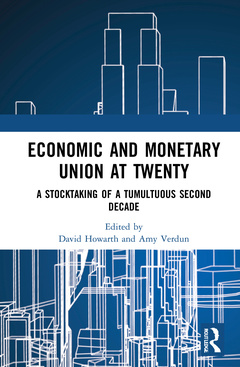Economic and Monetary Union at Twenty A Stocktaking of a Tumultuous Second Decade

The contributions to this book examine the two main asymmetries of the Euro Area as they have intensified during the second decade of Economic and Monetary Union (EMU): the first between monetary union (more supranational governance) versus ?economic? union (less centralised governance); the second between those Euro Area member states of the so-called ?core? and those of the ?periphery?.
EMU stands as one of the European Union?s (EU) flagship integration achievements. Set up in 1999, with the large majority of EU member states at the time, EMU was described as ?asymmetrical? even prior to its start. From the outset, it involved asymmetrical integration in monetary and ?economic? union. Although a major element of the blueprint that paved the way for the final stage of EMU, the concept of ?economic? union was insufficiently developed. The second decade of the single currency gave rise to a second asymmetry, namely one between those Euro Area member states of the ?core? and those of the ?periphery?. The ten contributions to this volume speak to one or both of these asymmetries, covering the major political, political economy and policy dimensions of EMU and the ongoing debates about necessary policy and institutional reforms to overcome these asymmetries and bolster Euro Area stability. The outbreak of the Coronavirus (Covid-19) Crisis in 2020 created unprecedented socio-economic challenges for Euro Area member states, heightening the perceived urgency of reform.
The chapters in this book were originally published as a special issue of the Journal of European Integration.
Introduction: Economic and Monetary Union at twenty: a stocktaking of a tumultuous second decade
David Howarth and Amy Verdun
1. EMU and political union revisited: what we learnt from the euro’s second decade
Dermot Hodson
2. Sui generis no more? The ECB’s second decade
Michele Chang
3. Economic and fiscal policy coordination after the crisis: is the European Semester promoting more or less state intervention?
Jörg S. Haas, Valerie J. D’Erman, Daniel F. Schulz and Amy Verdun
4. EMU and the Italian debt problem: destabilising periphery or destabilising the periphery?
Ton Notermans and Simona Piattoni
5. EMU and the Greek crisis: testing the extreme limits of an asymmetric union
George Pagoulatos
6. Euro adoption policies in the second decade – the remarkable cases of the Baltic States
Assem Dandashly and Amy Verdun
7. Democratic legitimacy in the post-crisis EMU
Ben Crum and Stefano Merlo
8. Gender, austerity, and support for EMU across generations
Susan Banducci and Peter Loedel
9. One money, two markets? EMU at twenty and European financial market integration
David Howarth and Lucia Quaglia
10. EMU’s asymmetries and asymmetries in German and French influence on EMU governance reforms
Joachim Schild
David Howarth is Professor of European Political Economy at the University of Luxembourg and a former Jean Monnet Chair at the University of Edinburgh; (co-)author or (co-)editor of four monographs, nineteen special issues/edited volumes and over ninety journal articles and chapters on European political economy topics.
Amy Verdun is Professor in European Politics and Political Economy at Leiden University and Professor in the Department of Political Science of the University of Victoria, B.C., Canada. She is the (co-)author or (co-)editor of two monographs, more than twenty books/special issues and over a hundred journal articles and chapters.
Date de parution : 09-2023
17.4x24.6 cm
Date de parution : 05-2021
17.4x24.6 cm
Thèmes d’Economic and Monetary Union at Twenty :
Mots-clés :
Euro Area; Political economy; Euro Area Sovereign Debt Crisis; Euro Area member states; Euro Area Crisis; EMU; Economic union; ESM Fund; Socio-economic challenges; European Semester; Banking Nationalism; ECB’s Mandate; Euro Area Member; Euro Area Periphery; German Government; EU Institution; EU Member State; Gdp Ratio; EDIS; Differentiated Integration; Euro Adoption; Federal Reserve; Financial Market Integration; Unconventional Monetary Policy; Emu Membership; ECB Monetary Policy; EU Economic Governance; Euro Area Summit; Emu Member State



